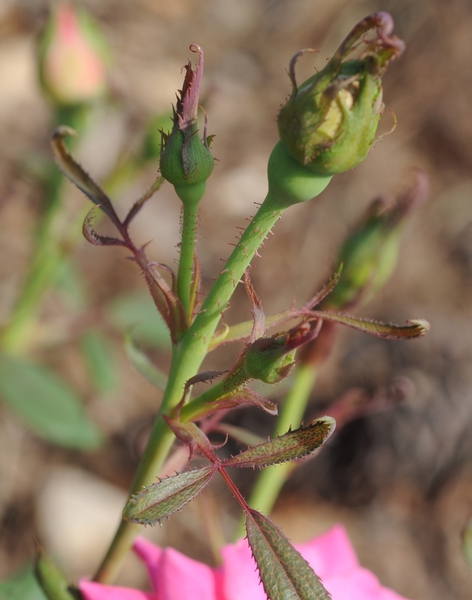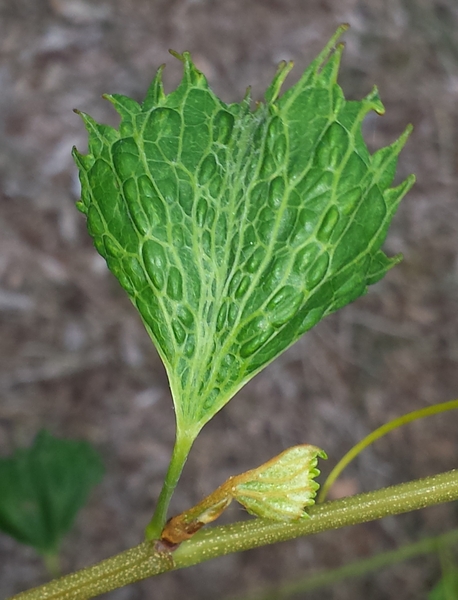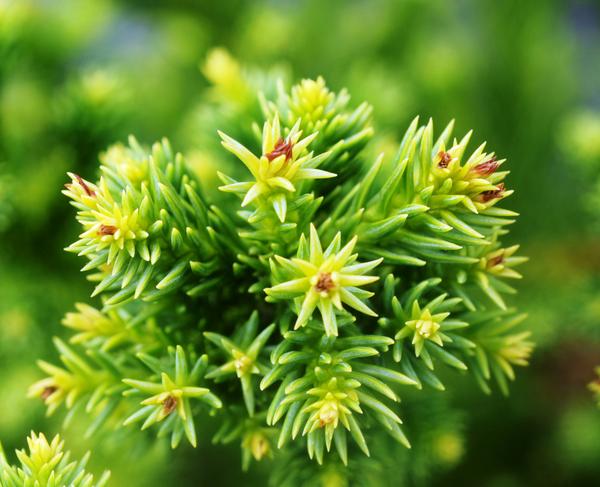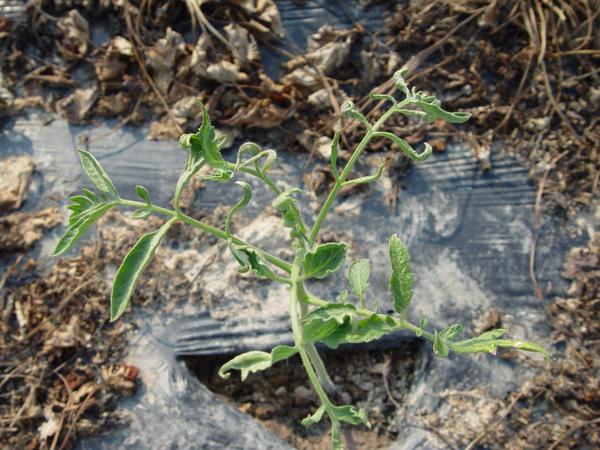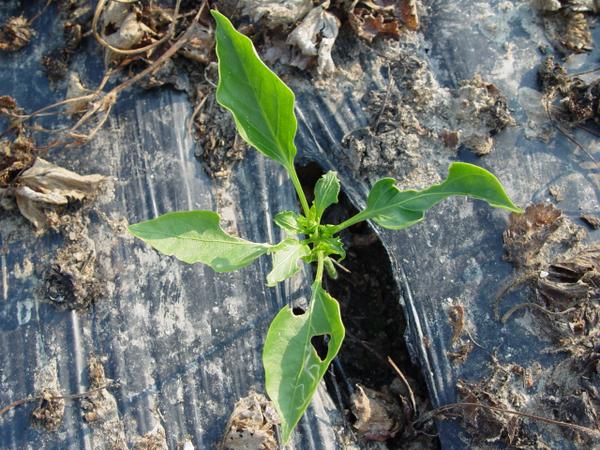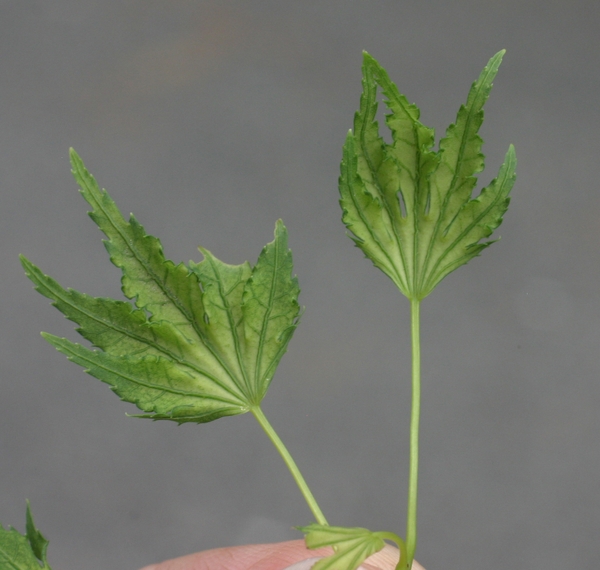Problem
Herbicide injury by Synthetic Auxins (SA) including 2,4-D, mecoprop, amniopyralid, aminocyclopyrachlor, clopyralid, dicamba, triclopyr and others. Crop injury may result from misapplication, spray drift, vapor drift, contamination (spray tank, measuring containers, fertilizer, etc.), and carryover in soil, mulch, hay, etc. Recently, suspected contamination of irrigation ponds has occured via runoff from adjacent treated properties.
Symptoms
- Acts only on broadleaf plants, not grasses.
- Epinastic twisting and downward curving of fully turgid (not wilted) stems and petioles. (curling is not always downward)
- Malformed leaves may be curled, cupped, strap-shaped or twisted.
- Chlorosis on new growth progressing to older tissue as plant senesces.
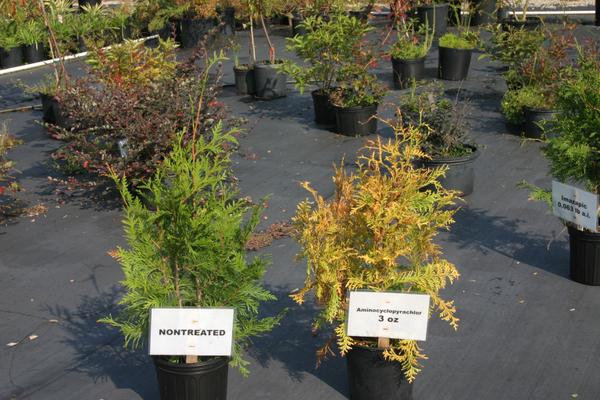
Aminocyclopyrachlor injures conifers from root uptake. The arborvitae on the right was exposed via root uptake. Photo take 4 months after treatment.
J. Neal CC BY-NC-SA 4.0
Plant Entry and Symptom Expression
Foliar applied and translocated throughout the plant. Symptoms of injury will be visible on new growth stems, petioles and then leaves within 48 hours of exposure; followed by chlorosis in about 7-10 days concluding with growth cessation of shoots and roots in about four weeks. Foliar absorption may occur through vapor drift if the ester formulation is applied. Root absorption is also possible in porous soils. Certain synthetic auxin herbicides, such as aminopyralid and aminocyclopyraclor, are more persistent in the soil and are more likely to be absorbed by root uptake than other SA herbicides.
Likely ways crops could be exposed to damaging levels of auxinic herbicides:
| Herbicide | Vapor drift | Spray drift | Soil residual / carry-over |
|---|---|---|---|
| 2,4-D amine | L | H | |
| 2,4-D ester | H | H | |
| aminocyclopyraclor | L | H | H |
| aminopyralid | L | H | H |
| dicamba | M | H | M |
| picloram | H | H | |
| triclopyr amine | L | H | |
| triclopyr ester | M | H | |
| Key (likelihood of exposure): H = high, M = moderate, L = low | |||
Similar Problems
Synthetic auxin injury may be confused with symptoms from:
- Desiccation – loss of cell turgor pressure; salt accumulation.
- Diflufenzopyr (Distinct) – auxin transport inhibitor; buildup of IAA.
- Acetolactate synthase (ALS) inhibitors such as imazapic (Cadre, Plateau, and others) and imazapyr (Arsenal, Chopper, and others) also cause cupped foliage but ALS-treated plants lack curled or twisted growth.
- Certain aphids and other piercing/sucking insects can induce cupped and curled foliage. Such insect injury is distinguished from SA herbicide injury by the presence of the pest and lack of systemic symptoms on other plant parts.
Herbicide Mode of Action Category
WSSA – 4
Useful Resources
North Carolina Agricultural Chemicals Manual
Southern Region Small Fruit Consortium
Southeastern US Vegetable Crop Handbook
Weed Management in Nurseries, Landscapes & Christmas Trees Information Portal
Herbicide Handbook, Weed Science Society of America
Applied Weed Science: Including the Ecology and Management of Invasive Plants (3rd Edition), Merrill Ross & Carol Lembi, pages 165, 170-172.
Publication date: July 13, 2015
Reviewed/Revised: Dec. 8, 2021
Recommendations for the use of agricultural chemicals are included in this publication as a convenience to the reader. The use of brand names and any mention or listing of commercial products or services in this publication does not imply endorsement by NC State University or N.C. A&T State University nor discrimination against similar products or services not mentioned. Individuals who use agricultural chemicals are responsible for ensuring that the intended use complies with current regulations and conforms to the product label. Be sure to obtain current information about usage regulations and examine a current product label before applying any chemical. For assistance, contact your local N.C. Cooperative Extension county center.
N.C. Cooperative Extension prohibits discrimination and harassment regardless of age, color, disability, family and marital status, gender identity, national origin, political beliefs, race, religion, sex (including pregnancy), sexual orientation and veteran status.

